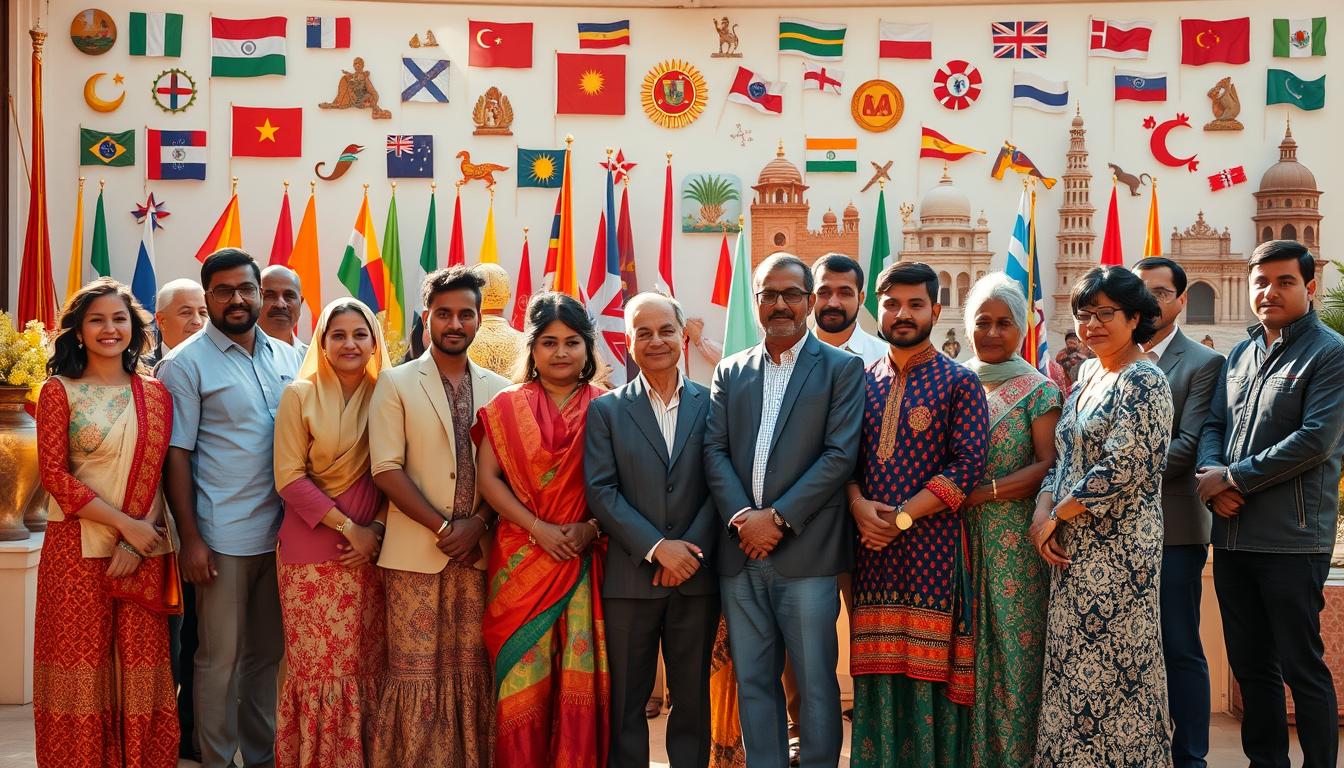Cultural Bridges: How Exchange Programs Benefit Immigrants and Host Communities
Cultural exchange programs are key to building bridges between immigrants and their host communities in the United States. They offer a chance for people to learn from each other and grow together. These programs help everyone understand different cultures better.
They also help people talk and work together more effectively. This leads to a society that values and celebrates diversity. As these programs grow, they help make our communities more welcoming and inclusive.
Understanding Cultural Exchange
Cultural exchange is when people share traditions, values, and experiences from different backgrounds. It helps us understand and appreciate different ways of life. By doing this, we grow personally and help build a stronger society.
Definition of Cultural Exchange
Cultural exchange takes many forms, like art, language, food, and customs. When we take part in these exchanges, we learn about others and share our own culture. This sharing helps us connect and understand each other better.
Importance in a Globalized World
In our connected world, cultural exchange is key to tolerance and understanding. Technology makes it easy for us to connect with people from other places. This connection helps us grow, builds stronger communities, and broadens our view of the world.
Historical Context of Exchange Programs
Exchange programs have a long history, aimed at building goodwill and understanding. They started with early diplomatic efforts and have evolved over time. Today, they help us understand how different cultures interact.
Brief History of Cultural Exchange Initiatives
The first cultural exchanges were set up to promote peace and respect. After wars, programs focused on rebuilding and education. They helped nations learn from each other.
Notable Exchange Programs Over the Decades
The Fulbright Program, started in 1946, is a key example. It helps people from different countries learn and grow together. Other programs like Rotary International’s Youth Exchange and the Congress-Bundestag Youth Exchange also play a big role. They show our dedication to connecting cultures and strengthening international bonds.
Benefits for Immigrants
Immigrants in cultural exchange programs gain many benefits. These programs help them grow and adapt in new places. They learn valuable skills and become more flexible in different settings.
Skill Development Through Experience
Being part of cultural exchange lets immigrants try new ideas and ways of working. This hands-on experience boosts their critical thinking and problem-solving. It makes them more employable and confident in a global job market.
Language Acquisition and Communication Skills
Learning the local language is key in cultural exchange. It helps immigrants connect well with their host communities. By improving their communication, they can join in social activities and build strong support networks. This is crucial for successful integration.
Advantages for Host Communities
Host communities get many benefits from cultural exchange activities. These activities can change their social and economic scenes. They bring in new practices and traditions, helping people understand different cultures better.
Being exposed to new views helps make communities more inclusive. It also gets more people involved in community activities.
Enrichment of Local Culture
Different cultures add a lot to local culture. Festivals, art shows, and food events bring unique expressions to the community. These events help people interact more, learn from each other, and appreciate different lifestyles.
When people join in cultural activities, they feel proud of their heritage. They also enjoy the new traditions brought in by exchange participants.
Economic Contributions and Innovation
Exchange participants help the economy in many ways. They bring in tourists and locals who spend money on dining, shopping, and services. This boosts local businesses.
New ideas from cultural exchange can also spark entrepreneurship. It encourages people to explore global markets and new practices. This exchange helps the economy grow and boosts creativity in the community.
Key Exchange Programs Operating in the U.S.
Exchange programs are key to understanding and working together across cultures. The Fulbright Program is a top example in the U.S., focusing on education and cultural exchange. The J-1 Visa helps make these exchanges possible, offering chances for students, professionals, and au pairs to share their cultures.
Overview of the Fulbright Program
The Fulbright Program started in 1946 to boost international education exchange. It gives grants for studying, teaching, and research in over 160 countries. This program lets people dive into different cultures and share their views, helping Americans and others understand each other better.
The J-1 Visa: Cultural Exchange and Workforce Development
The J-1 Visa is vital for cultural exchange in the U.S. It supports many programs that bring people here for short educational and cultural experiences. This visa offers internships, work-and-travel, and au pair placements. It helps participants learn new skills, improve their careers, and share their cultures, enriching host communities.
Building Empathy and Understanding
Cultural exchange programs are key in building empathy among people from different backgrounds. They offer immersive experiences where participants meet face-to-face. This direct interaction helps break down barriers and lets people share their stories and values.
It’s a chance to overcome stereotypes and prejudices. This way, we can create a more inclusive society.
Overcoming Stereotypes and Prejudices
Breaking down stereotypes is crucial for a more inclusive world. When people interact meaningfully, they learn about each other’s cultures and beliefs. These exchanges humanize individuals and dispel myths that lead to discrimination.
As a result, people start to see each other in a new light. They move away from bias and towards understanding.
Fostering Mutual Respect and Tolerance
Empathy leads to mutual respect and tolerance. Cultural exchanges provide a space for open discussions. This helps participants bond despite their differences.
These programs focus on common goals and values. They build a sense of community among people from different backgrounds. This strengthens our society’s fabric.
The Role of Educational Institutions
Educational institutions are key in cultural exchange through college exchange programs. These programs help students understand the world better. They also help students grow personally and academically.
Colleges and Universities in Exchange Endeavors
Colleges and universities in the U.S. have teamed up with schools worldwide. This creates chances for students to study abroad. It’s a way to bring different cultures together, making learning more interesting.
By welcoming international students, schools become more vibrant. It encourages teamwork and new ideas.
Impact on Student Perspectives and Career Paths
College exchange programs change students’ views of the world. They learn about different cultures and ways of learning. This broadens their understanding of global issues.
It also sharpens their critical thinking and problem-solving skills. This prepares them for a wide range of careers in today’s global world. Employers see the value in this experience, making these students more attractive to employers.
Challenges and Barriers in Cultural Exchange
Engaging in cultural exchange programs comes with many challenges. These can be split into legal and immigration hurdles, and social and cultural integration difficulties. Knowing these barriers is key to making exchanges more inclusive and successful.
Legal and Immigration Hurdles
Legal barriers often make it hard to join exchange programs. Visa and residency rules can be a big problem. Immigrants may have to go through long application processes and meet strict criteria.
These legal obstacles can stop people from taking part in cultural experiences. It’s a big loss for everyone involved.
Social and Cultural Integration Difficulties
When newcomers try to fit in, they often face cultural integration issues. Social dynamics can lead to tension, making it hard for immigrants and locals to connect. Different cultural norms can make things uncomfortable.
Without ways to overcome these challenges, cultural exchange may not reach its full potential. It’s important to find solutions to these problems.
Successful Case Studies
Many stories show how cultural exchange changes lives for immigrants and host communities. These tales prove the power of cultural exchange programs. They show how people grow and communities get richer.
Immigrant Stories of Transformation
Immigrants talk about how cultural exchange programs changed them. For example, a young artist from Mexico improved her skills in a New York gallery. This experience boosted her career and helped her show her work across the U.S.
These stories show how cultural exchange can deeply change someone’s life.
Host Community Experiences and Testimonials
Host communities also gain a lot from cultural exchange. Local businesses get more customers and foot traffic from the diversity of exchange participants. People in the community thank immigrants for sharing new ideas and perspectives.
A resident of a small town said,
“The exchange program not only enriched our community’s culture but also opened our eyes to different traditions and customs. We have become more inclusive and understanding.”
These stories show that cultural exchange is a two-way street. Everyone involved learns and grows.
The Future of Cultural Exchange Programs
The world of cultural exchange is changing fast. New trends show a big move towards using technology for virtual exchanges. This change helps more people join in and overcomes money and distance problems.
As we face issues like migration and health crises, how we share cultures must change too.
Trends Shaping Future Exchange Initiatives
New trends in cultural exchange focus on being more open and using tech. These changes include:
- Virtual exchange programs that use online spaces for cultural talks.
- The use of social media to spread cultural knowledge and chances to connect.
- More emphasis on multilateral exchange partnerships, making global teamwork easier.
Potential Areas for Growth and Expansion
The future of cultural exchange offers many chances to grow. Areas to look into include:
- Youth-targeted initiatives to get younger people involved in cultural learning.
- Local programs that bring people together and connect them worldwide.
- Work-related exchanges that help professionals from different fields share skills and work together.
Policy Implications on Cultural Exchange
Looking into policy implications for cultural exchange shows how key government support and rules are. With government help, these programs can grow and touch more people. This leads to a deeper sharing of ideas, cultures, and experiences.
As countries face a complex world, investing in cultural programs is more important than ever.
Government Support and Regulation
Government backing is crucial for cultural exchange programs to last. This support includes money and rules that make joining these programs easier. Good rules help everyone get involved in cultural exchanges.
Government policies affect how accessible and big these programs can be. They shape how communities come together and grow.
Importance of Advocacy for Continuing Programs
It’s important to promote cultural exchange to show its benefits to both newcomers and local communities. People like teachers, leaders, and advocates need to work together. They should push for more money and support for these programs.
This effort helps make society richer, builds understanding, and supports a more welcoming future.
Conclusion: Bridging Cultures for a Better Tomorrow
Cultural exchange programs bring many benefits. They help people from different backgrounds talk and understand each other better. They also make local cultures richer and help the economy grow.
When people share their experiences, they grow personally. Communities become more vibrant and diverse. This leads to a society that values working together and coming up with new ideas.
Summary of Key Benefits
Cultural exchange programs offer many advantages. They help people learn new skills and improve their language skills. They also make communities more diverse and economically stronger.
These programs make life better for everyone. They teach us to respect and understand each other. This is why they are so important for our future.
Call to Action for Support and Participation
We need to support cultural exchange programs for a better future. By joining these programs, we can change lives and build a world based on empathy and teamwork. It’s a chance to be part of something bigger than ourselves.
Let’s work together to make a stronger, more connected world. This way, we can achieve lasting peace and understanding.
FAQ
What is cultural exchange?
How can I participate in international exchange programs?
What are the benefits of cultural exchange for immigrants?
What advantages do host communities gain from cultural exchange programs?
What are some notable exchange programs available in the U.S.?
How do cultural exchange programs help in overcoming stereotypes?
What challenges do cultural exchange programs face?
What is the future outlook for cultural exchange initiatives?
Why is advocacy important for cultural exchange programs?
Published on: 28 de March de 2025

Luke Martin
Luke Martin, author of Credwallets.com, is a mathematics graduate with a specialization in financial markets. Known for his love of pets and his passion for sharing knowledge, Luke created the site to provide valuable insights into the complexities of the financial world. His approachable style and dedication to helping others make informed financial decisions make his work accessible to all, whether they're new to finance or seasoned investors.







